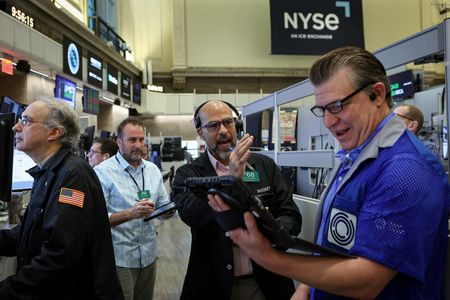By Jamie McGeever
ORLANDO, Florida (Reuters) -U.S. tech shares stumbled again but the Dow climbed to a new high on Wednesday as investors geared up for an end to the U.S. government shutdown, while oil prices slumped on reports that crude supply will be higher than previously thought.
More on that below. In my column today I look at why the end of the U.S. government shutdown won’t lift the economic fog for some time. Indeed, some key indicators like the unemployment and CPI inflation rates for October may never be released.
If you have more time to read, here are a few articles I recommend to help you make sense of what happened in markets today.
1. US House to vote on deal to end longest governmentshutdown in history 2. US Labor Department urged to prioritize Novemberemployment, CPI data post-shutdown 3. How to ride the stocks momentum wave while avoiding awipeout: Helen Jewell 4. Nvidia supplier Foxconn bullish on AI demand, teasesOpenAI announcement 5. Europe needs to deliver tech promise for more years like2025: Mike Dolan
Today’s Key Market Moves
* STOCKS: New highs for the Dow, France, Spain, UK,pan-European benchmarks, Japan’s Topix. Euro era high in Italy. * SHARES/SECTORS: U.S. comms services, energy, consumerdiscretionaries down 1% or more. Healthcare +1.4%, financials+0.9%. Airlines spike. AMD +9%, Paramount Skydance -7%. * FX: Dollar index ends flat. Official USD/CNY fix 7.0833lowest since October last year. USD/JPY new 9-month high above155.00, EUR/JPY new record high. EUR/GBP highest since April2023. * BONDS: U.S. Treasury curve bull flattens, long-datedyields down 4 bps. 10-year auction is fairly weak. * COMMODITIES/METALS: Oil slumps 4%. Silver +4% withinsight of last month’s record high.
Today’s Talking Points
* AI bursting with energy
The scale of AI investment over the coming years is staggering enough when measured in dollars. It’s equally staggering in terms of the power and energy required to run all these data centers. Can the demand be met? If so, what are the inflationary and economic impacts?
Take the Stargate project. According to UniCredit, it will target 10 gigawatts of electrical power by 2029, the equivalent of ten medium-sized nuclear power plants. Morgan Stanley estimates total U.S. data center power demand through 2028 at 69 GW, but warns of a potential 44 GW shortfall, barring creative “time to power” solutions.
* When QE is not QE
It won’t be long until the Fed starts buying bonds again to expand its balance sheet, says New York Fed president John Williams. The Fed skeptics and ‘doomers’ on financial social media say this is proof the Fed will never shake its addiction to quantitative easing, and inflation and dollar debasement are inevitable.
Not really. These purchases would be part of a technical effort to ensure bank reserves are “ample”, allowing the Fed to keep control over ultra short-term interest rates and money market liquidity. It would probably involve the purchase of T-bills, not long-dated bonds, and would have no implication for monetary policy.
* Labour pains
Pressure is mounting on UK Prime Minister Keir Starmer, and speculation is rife he may soon face an internal leadership challenge. His poll ratings have sunk since the 2024 election, unemployment is the highest in nearly six years, and later this month he is expected to break a manifesto pledge not to raise income tax.
What does this mean for markets? The FTSE 100 is at a record high but sterling is at a two and a half year-low against the euro and teetering on a break below $1.30. The government will be desperate to get the bond market onside, and avoid a return of what TS Lombard economist Dario Perkins termed the “moron risk premium” during former PM Liz Truss’s short-lived tenure.
End of US government shutdown won’t lift economic fog
The end of the longest-ever U.S. government shutdown is in sight, which means official economic data will soon be forthcoming. But even if investors and the Federal Reserve are breathing a sigh of relief, the signals they should soon get might not be all that reliable.
Some of the delayed figures should begin to trickle out quickly. Economists at Morgan Stanley predict the September nonfarm payrolls report will probably be released a few days after the shutdown ends, as the data has already been collected.
It will be much longer before the October report lands, however, but when it does, it could be missing one key element: the unemployment rate.
For the first time since 1948, the “household survey,” from which the unemployment rate is calculated, was not carried out last month, according to Claudia Sahm, chief economist at New Century Advisors. Unlike the “establishment survey” which determines the monthly change in payroll jobs, subsequent household surveys don’t ask about prior months.
This data gap could factor into the U.S. central bank’s interest rate decision in December, as Fed Chair Jerome Powell has made clear the labor market side of the central bank’s dual mandate has weighed more heavily on recent policy decisions than inflation.
To be sure, what employment data the Fed does have to go on is not painting a pretty picture. Based on private-sector data and the limited government figures available, economists at Goldman Sachs now reckon nonfarm payrolls declined by 50,000 in October. That would be only the second monthly drop since December 2020, and the biggest decline in more than five years.
A report last week from global outplacement firm Challenger, Gray & Christmas showed planned layoffs soared to more than 150,000 in October, the highest reading for that month since 2003.
The Fed, however, may put its rate cuts on hold as long as the official employment and other data remain incomplete and potentially unreliable.
“What do you do if you’re driving in the fog? You slow down,” Powell told reporters last month after the end of the Fed’s policy meeting.
INFLATION DISTORTION
The inflation and spending picture should remain hazy as well.
Using the 2013 shutdown as a rough guideline, Morgan Stanley’s economists believe October inflation and consumer spending data will not be released in time for the Fed’s December 9-10 policy meeting, never mind the November figures.
UBS economists are even more pessimistic about getting an update on CPI inflation. They say the October report, originally scheduled for Thursday, may not be released at all because the Bureau of Labor Statistics was closed for the full month, so price quotes were not collected.
Getting even deeper into the CPI weeds, UBS notes that October data points are used as a base for some price index calculations that affect other months. That means November, December, and even April CPI inflation data could be distorted.
Meanwhile, there’s a chance that October retail sales data may also not be released before the Fed’s next meeting. According to UBS economists, retail sales data are collected by mail, fax, or telephone, and aggregated within six business days of the reference month. Was September’s data collected?
“We could be without a key statistic for understanding a large chunk of U.S. GDP for some time,” they wrote on Friday.
Indeed, it’s even possible that the unemployment and CPI inflation rates for October are never released, because the data were either partially collected or not collected at all.
So while the wave of relief lifting most stock markets this week is understandable, the end of the shutdown should not be confused with a return to economic clarity.
What could move markets tomorrow?
* Australia unemployment (October) * Chinese earnings – JD.com and Tencent * Japan wholesale inflation (October) * UK industrial production (September) * UK trade (September) * UK GDP (Q3, prelim) * Euro zone industrial production (September) * U.S. Treasury auctions $25 billion of 30-year bonds * U.S. Federal Reserve officials scheduled to speak includeSt. Louis Fed’s Alberto Musalem and Cleveland Fed’s Beth Hammack * U.S. earnings – Disney, Cisco, Applied Materials
Want to receive Trading Day in your inbox every weekday morning? Sign up for my newsletter here.
Opinions expressed are those of the author. They do not reflect the views of Reuters News, which, under the Trust Principles, is committed to integrity, independence, and freedom from bias.
(By Jamie McGeever;)











